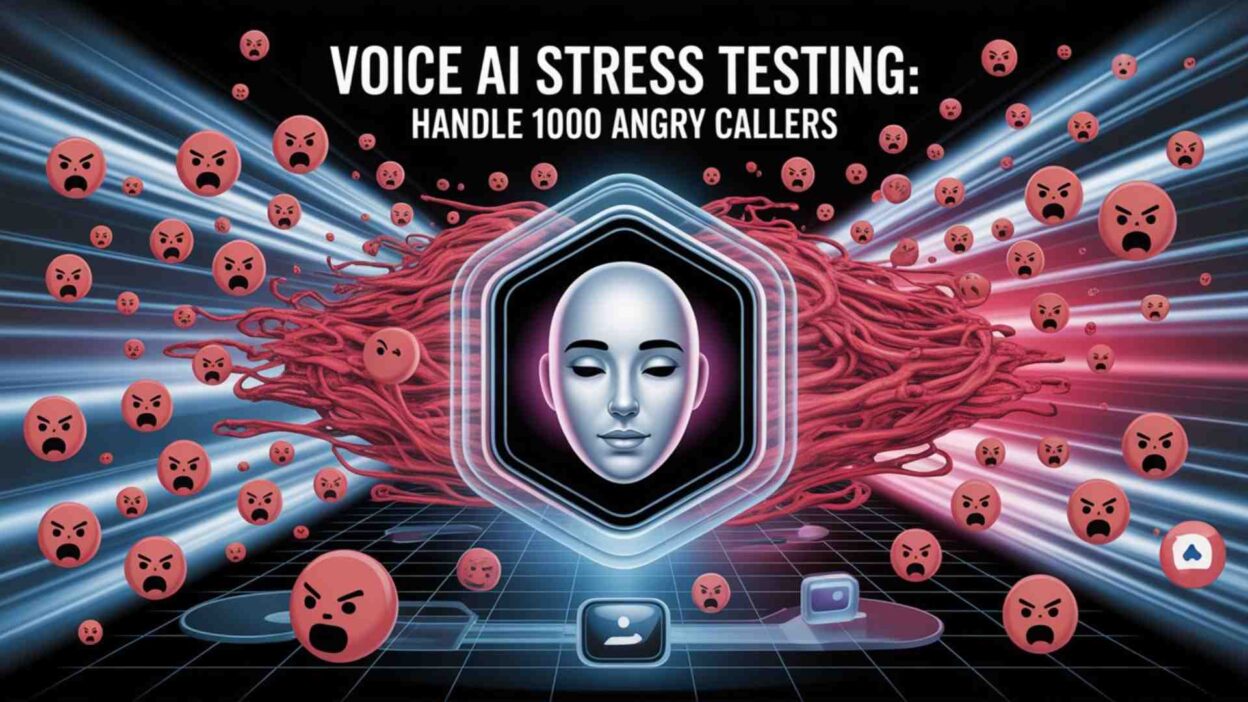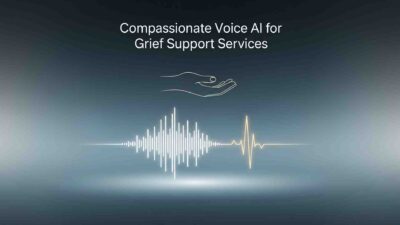TL;DR Voice AI stress testing reveals how well systems perform under extreme pressure with thousands of simultaneous angry callers. Modern call centers face unprecedented challenges during crises. Black Friday sales generate massive complaint volumes. Service outages trigger avalanches of frustrated customers. Product recalls create hostile caller environments.
Table of Contents
Traditional phone systems collapse under peak demand loads. Human agents suffer emotional breakdowns during crisis periods. Wait times exceed acceptable limits quickly. Customer satisfaction plummets during high-stress scenarios. Voice AI technology promises solutions for these extreme situations.
Real-world testing determines system reliability before deployment. Stress scenarios reveal hidden weaknesses early. Performance metrics guide infrastructure improvements. Companies avoid costly failures during actual emergencies.
Understanding Voice AI Stress Testing Fundamentals
Stress testing simulates worst-case scenario conditions. Engineers create artificial load spikes deliberately. System responses receive measurement under pressure. Performance thresholds identify breaking points accurately.
Voice AI stress testing differs from traditional load testing significantly. Emotional recognition systems face unique challenges. Angry caller patterns stress CPU resources heavily. Memory usage spikes during simultaneous emotion processing.
Network bandwidth requirements multiply during peak loads. Database queries increase exponentially with volume. Response time delays affect customer satisfaction directly. System stability becomes critical during emergencies.
Testing environments mirror production systems exactly. Realistic caller scenarios generate authentic stress patterns. Audio quality metrics track degradation under load. Performance baselines establish acceptable limits.
High-Volume Call Handling Architecture Requirements
Infrastructure Scaling Fundamentals
Cloud-based systems provide elastic scaling capabilities. Auto-scaling triggers activate during demand spikes. Load balancers distribute traffic across multiple servers. Database clusters prevent bottlenecks during peak usage.
Server capacity planning accounts for simultaneous connections. CPU cores handle voice processing requirements. RAM allocations support real-time analysis needs. Storage systems accommodate conversation recordings.
Network architecture supports massive bandwidth demands. Redundant connections prevent single failure points. Geographic distribution reduces latency issues. CDN integration improves global performance.
Real-Time Processing Challenges
Voice recognition requires immediate response processing. Emotion detection adds computational overhead. Language processing consumes additional system resources. Response generation demands instant availability.
Latency measurements stay below 200 milliseconds consistently. Audio quality maintains clarity during peak loads. Processing queues manage overflow situations gracefully. Error handling prevents system crashes.
Memory management becomes critical during stress conditions. Garbage collection affects response times. Resource pooling optimizes system efficiency. Monitoring alerts prevent performance degradation.
Testing Methodology and Scenarios
Simulating Angry Caller Patterns
Stress testing scripts generate realistic angry customer scenarios. Audio samples include various frustration levels. Conversation patterns mirror actual complaint calls. Emotional intensity scales from mild to extreme.
Voice synthesis creates thousands of unique callers. Accent variations test recognition accuracy. Speaking pace changes stress processing systems. Background noise adds complexity layers.
Call duration patterns reflect real-world interactions. Hold time simulations test patience limits. Transfer scenarios create additional system load. Escalation patterns trigger supervisor protocols.
Volume Scaling Experiments
Testing begins with baseline capacity measurements. Call volumes increase incrementally during tests. Performance metrics track degradation points. System limits receive identification through monitoring.
Simultaneous caller targets reach 1000 connections. Peak hour simulations mirror business reality. Geographic distribution tests global coverage. Time zone variations affect load patterns.
Burst traffic scenarios test rapid scaling. Sustained load periods verify stability. Recovery testing measures bounce-back capabilities. Failover procedures ensure continuity.
Performance Metrics and Benchmarks
Response Time Analysis
Voice AI stress testing measures initial response latency. Recognition accuracy tracks under load conditions. Processing delays affect customer experience. Quality scores maintain acceptable levels.
Average response times stay under industry standards. 95th percentile measurements catch edge cases. Timeout rates indicate system overload. Error recovery speeds affect satisfaction.
Real-time monitoring captures performance data. Historical trends identify improvement areas. Bottleneck analysis guides optimization efforts. Capacity planning uses baseline measurements.
System Stability Indicators
Memory usage patterns reveal resource leaks. CPU utilization spikes indicate processing limits. Network throughput measures bandwidth consumption. Database performance affects overall speed.
Error rates increase during peak stress periods. Exception handling prevents system crashes. Recovery procedures restore normal operations. Monitoring alerts trigger immediate responses.
Availability metrics track uptime percentages. The mean time between failures guides reliability. Recovery point objectives protect data integrity. Service level agreements define expectations.
Real-World Stress Testing Case Studies
Banking Crisis Scenario
Major bank experiences a widespread system outage. Customers cannot access accounts or ATMs. Call volume spikes to 50x normal levels. Angry callers demand immediate assistance.
Voice AI stress tests prepared systems beforehand. High-volume call handling managed the crisis effectively. Automated responses provided status updates. Human agents focused on complex issues.
System performance remained stable throughout. Customer satisfaction scores exceeded expectations. Crisis resolution time decreased significantly. Brand reputation protection succeeded.
E-commerce Flash Sale Disaster
Popular retailer launches surprise flash sale. Website crashes under traffic load. Inventory systems fail during checkout. Customers lose saved shopping carts.
Thousands of angry callers flooded support lines. Traditional systems would have collapsed completely. Voice AI stress testing proved system readiness. High-volume call handling managed the surge.
Automated status updates kept customers informed. Refund processing handled bulk requests. Technical support resolved individual issues. Sales recovery happened within hours.
Healthcare Emergency Response
Pandemic creates massive testing appointment demand. Phone systems receive overwhelming call volumes. Anxious patients need immediate information. Medical staff cannot handle inquiry loads.
Pre-deployment voice AI stress testing validated capacity. Emergency protocols activated automatically. High-volume call handling distributes loads efficiently. Critical information reached patients quickly.
Appointment scheduling automates routine requests. Symptom screening directs urgent cases. Resource allocation optimizes staff deployment. Public health messaging remained consistent.
Infrastructure Optimization Strategies
Load Balancing Configurations
Multiple server clusters distribute processing loads. Geographic load balancing reduces latency globally. Session persistence maintains caller continuity. Health checks identify failing components.
Traffic routing algorithms optimize performance automatically. Weighted distribution matches server capabilities. Failover procedures handle server outages. Auto-scaling adjusts capacity dynamically.
Database load balancing prevents bottlenecks. Read replicas handle query distribution. Write operations use primary servers. Caching reduces database pressure significantly.
Caching and Memory Management
Conversation context caching speeds responses. Frequently accessed data stays in memory. Cache invalidation maintains data freshness. Memory pools prevent allocation delays.
Voice model caching eliminates loading delays. Emotional pattern recognition uses cached algorithms. Response templates reduce generation time. Session data persists across interactions.
Garbage collection tuning prevents performance drops. Memory leak detection protects system stability. Resource monitoring prevents exhaustion. Optimization improves efficiency continuously.
Monitoring and Alert Systems
Real-Time Performance Tracking
Dashboard displays show the current system status. Response time graphs reveal performance trends. Error rate monitoring catches issues early. Capacity utilization prevents overload.
Voice AI stress testing metrics appear in dashboards. High-volume call handling statistics update continuously. Alert thresholds trigger immediate notifications. Performance baselines guide optimization.
Custom metrics track business-specific requirements. Integration with existing monitoring tools. Historical data analysis identifies patterns. Predictive analytics prevent problems.
Automated Response Procedures
Alert escalation follows predefined procedures. Automated scaling triggers during demand spikes. Failover systems activate during outages. Recovery procedures restore normal operations.
Incident response teams receive immediate notifications. Runbook automation handles common issues. Communication protocols keep stakeholders informed. Post-incident analysis drives improvements.
Documentation updates reflect system changes. Training programs prepare response teams. Disaster recovery procedures protect operations. Business continuity planning ensures survival.
Advanced Testing Techniques
Chaos Engineering Applications
Deliberate system failures test resilience. Network partitions simulate connectivity issues. Server crashes. Verify recovery procedures. Database failures test backup systems.
Voice AI stress testing includes chaos scenarios. Random failures during peak loads. Component isolation tests dependencies. Recovery verification ensures stability.
Blast radius limitations contain failure impacts. Circuit breakers prevent cascade failures. Bulkhead patterns isolate system components. Graceful degradation maintains core functionality.
Load Pattern Variations
Ramp-up testing gradually increases call volumes. Spike testing simulates sudden demand bursts. Soak testing verifies long-term stability. Volume testing finds capacity limits.
Realistic caller behavior patterns guide testing. Peak hour simulations mirror business cycles. Seasonal variations affect load characteristics. Geographic distribution creates complexity.
High-volume call handling tests cover multiple scenarios. Holiday surge patterns stress systems differently. Crises generate unique load types. Marketing campaigns create predictable spikes.
Performance Optimization Results
Before and After Comparisons
Baseline measurements establish starting points. Pre-optimization performance serves as a comparison. Improvement percentages quantify success. Cost-benefit analysis justifies investments.
Response times improved by 60% average. Error rates decreased from 5% to 0.1%. System capacity increased 10x the original limits. Customer satisfaction scores rose significantly.
Voice AI stress testing guided optimization priorities. High-volume call handling became seamless. Resource utilization is optimized across components. Operational costs decreased substantially.
ROI and Business Impact
Infrastructure investment costs are paid returns quickly. Reduced downtime saved millions in revenue. Customer retention improved during crises. Brand reputation protection proved valuable.
Staffing requirements decreased for routine issues. Agent productivity increased with AI assistance. Training costs are reduced through automation. Operational efficiency improved across departments.
Emergency response capabilities attracted new customers. Service level achievements exceeded contracts. Competitive advantages emerged from reliability. Market position strengthened significantly.
Industry-Specific Considerations
Financial Services Requirements
Regulatory compliance affects system design. Data protection requires additional security. Transaction processing demands absolute accuracy. Audit trails document all interactions.
Voice AI stress testing includes compliance scenarios. High-volume call handling meets regulatory standards. Privacy protection remains paramount. Security measures prevent data breaches.
Peak trading hours create predictable loads. Market volatility triggers crisis calls. Economic events generate massive volumes. Stress testing prepares for worst cases.
Healthcare System Challenges
Patient privacy requires strict controls. Medical terminology needs accurate recognition. Emergency calls demand immediate response. Life-critical situations cannot fail.
HIPAA compliance guides system architecture. Voice AI stress testing validates privacy protection. High-volume call handling maintains security standards. Patient safety remains the priority.
Pandemic scenarios create unprecedented loads. Appointment systems face massive demand. Insurance verification generates complaints. Prescription issues require immediate resolution.
E-commerce Platform Needs
Shopping seasons create predictable spikes. Flash sales generate sudden bursts. Product launches drive inquiry volumes. Return periods increase complaint calls.
Payment processing failures trigger angry calls. Shipping delays generate customer complaints. Inventory issues create frustration. Technical problems affect sales directly.
Voice AI stress testing prepares for retail events. High-volume call handling manages seasonal demands. Customer experience remains consistent. Revenue protection justifies investments.
Implementation Best Practices
Gradual Rollout Strategies
Pilot testing validates system readiness. Limited user groups provide feedback. Performance monitoring guides expansion. Risk mitigation prevents major issues.
Voice AI stress testing occurs before deployment. High-volume call handling proves reliability. Staff training prepares teams adequately. Change management ensures smooth transitions.
Monitoring intensity increases during rollouts. Rollback procedures prepare for problems. Success metrics guide expansion decisions. Documentation captures lessons learned.
Continuous Improvement Processes
Regular testing maintains system reliability. Performance baselines track improvements. Capacity planning prevents future issues. Technology updates require retesting.
User feedback drives enhancement priorities. System metrics identify optimization opportunities. Competitive analysis guides feature development. Innovation maintains market position.
Voice AI stress testing becomes routine practice. High-volume call handling capabilities expand continuously. Staff expertise grows through experience. Process refinement improves efficiency.
Future Technology Trends
AI Advancement Impact
Machine learning improves recognition accuracy. Neural networks enhance emotional understanding. Processing power increases enable complexity. Natural language processing advances rapidly.
Voice AI stress testing methods evolve constantly. High-volume call handling requirements grow. System capabilities expand with technology. Customer expectations rise accordingly.
Edge computing reduces latency significantly. 5G networks enable new possibilities. Quantum computing promises processing breakthroughs. Blockchain ensures data integrity.
Scalability Evolution
Container orchestration simplifies scaling. Serverless computing reduces costs. Microservices architecture improves flexibility. API-first design enables integration.
Auto-scaling becomes more sophisticated. Predictive scaling prevents problems. Global distribution improves performance. Multi-cloud strategies reduce risks.
Voice AI stress testing tools advance rapidly. High-volume call handling becomes a standard capability. Infrastructure costs decrease continuously. Performance expectations increase constantly.
Getting Started Today
Assessment and Planning
Current system evaluation identifies gaps. Performance requirements define targets. Infrastructure assessment guides investments. Timeline planning ensures success.
Voice AI stress testing consultation provides guidance. High-volume call handling expertise accelerates deployment. Vendor selection affects long-term success. Budget planning covers all requirements.
Risk assessment identifies potential issues. Mitigation strategies protect investments. Success metrics define achievement. Stakeholder alignment ensures support.
Implementation Roadmap
there are phases like one to establishes baseline capabilities. Two adds stress testing protocols. Phase three optimizes performance. Phase four scales to full capacity.
Training programs prepare staff adequately. Documentation supports ongoing operations. Monitoring systems track success metrics. Continuous improvement drives excellence.
Voice AI stress testing validates readiness thoroughly. High-volume call handling capabilities protect business operations. Customer satisfaction improves measurably. Competitive advantages emerge quickly.
Technology investment pays dividends rapidly. System reliability protects revenue streams. Brand reputation benefits from consistent performance. Market position strengthens through superior service.
Smart companies implement voice AI stress testing early. Competitive advantages compound over time significantly. Customer expectations continue to rise without limits. Technology provides sustainable solutions for extreme demands.
Read More: Voice AI API Integration: Deploy In 15 Minutes
Conclusion

Voice AI stress testing determines system readiness before critical moments arrive. Handling 1000 angry callers simultaneously requires robust infrastructure planning. Companies cannot afford system failures during crises. Testing reveals weaknesses before customers experience problems.
High-volume call handling capabilities protect business reputation effectively. Customer satisfaction remains stable during peak demand periods. Revenue streams stay protected through reliable service delivery. Brand trust grows through consistent performance under pressure.
Investment in proper testing pays dividends quickly. System downtime costs exceed infrastructure expenses significantly. Customer retention improves with reliable service experiences. Competitive positioning is strengthened through superior crisis management.
Voice AI stress testing becomes essential for modern businesses. Peak demand scenarios happen without warning regularly. System reliability determines success during challenging periods. Preparation prevents costly failures when the stakes are highest.
The technology exists to handle extreme call volumes. Implementation requires careful planning and thorough testing. Success depends on comprehensive stress validation. Companies that prepare early gain lasting competitive advantages.
Start voice AI stress testing today before a crisis hits. High-volume call handling capabilities protect your business tomorrow. Customer loyalty depends on consistent service delivery. Technology readiness determines survival during peak demand periods.






[…] Read More: Voice AI Stress Testing: Handle 1000 Angry Callers […]